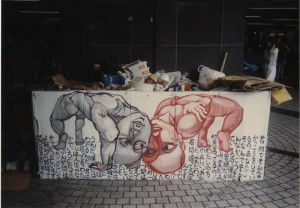Using art to change the world
By Naoko Sakokawa,
Photographer and author
 As a child I lived on a beautiful island called Tanegashima, or flower seed island, which is located close to the south most part of the Kyushu island. I was brought up there with lots of other relatives and led a serene and happy childhood even though my parents worked hard as farmers and we were economically not as rich as people in the big cities in Japan.
As a child I lived on a beautiful island called Tanegashima, or flower seed island, which is located close to the south most part of the Kyushu island. I was brought up there with lots of other relatives and led a serene and happy childhood even though my parents worked hard as farmers and we were economically not as rich as people in the big cities in Japan.
Today I am a photographer and author and even though I live in Shinjuku, which is one of the biggest and busiest areas in Tokyo, I use my work is to capture my memories of the small farm. I want to bring to the big city the intimacy of a close-knit community that I experienced on the island..
How do I do this as a photographer and a woman? To thrive in Japanese culture that is male-dominated I take the stance that a working woman must not push the gender issue on to people’s faces because I could create hostility. So, my photography brings important social issues through the so called “softer” themes such as art and food. My new book, “Food Jobs”, is on the popular theme of eating healthy and cheaply but more important it is about protecting local community through food. That means, I write and take photographs of menus served in small cafes and restaurants in Shinjuku that have been in business for several decades but are now winding-up because of tough competition from posh restaurants owned by rich companies that can afford the expensive rents in the shiny new buildings. I am greatly disturbed by this kind of modernization which is making urban space utterly materialistic.
By shooting nostalgic dishes and aging chefs who have served cheap and healthy dishes for a lifetime, I want to convey the deeper message, which is, lets protect our vanishing communities. Now if I took this theme and brought it out as a feminist activity, I face the risk of being ignored, to say the least, in Japan. The real fact is, that couched in art, I am attacking current policies made by men holding powerful leadership positions. They are taking decisions to turn our cities turning into anonymous skyscrapers.. Its really ironic, but recently my photographs have started a citizens protest campaign to stop this kind of cruel infrastructure. People have collected 15,000 signatures so far and we will keep going. I might be a hero if we can fight to stop the bigwigs up there!
Yet another landmark in my work is my photographs of the homeless people in Shinjuku, a project I began almost a decade ago. In this project, I not only convey the voices of the homeless who are treated as outcasts by mainstream society but also focus on the beauty of building close relationships between people, something that is missing in the big cities. In my book I record the time I spent developing trust with the homeless people before I started taking their photographs. Human relationships in Tokyo have dwindled to materialistic exchanges and it is common practice to pay a few cents to the homeless to take their photos and then simply forget them. I want to change this by showing people, through my photographs, certain beautiful aspects of the homeless and how these people taught me important lessons As usual, I took the artistic approach by photographing the unique art displayed on the cardboard boxes that are their homes. When I started this work, my friends told me a young woman should not mix with rough jobless male laborers because she would get a reputation as being strange. But, in fact, it was the opposite. I found the homeless, who are overwhelmingly male, totally devoid of gender discrimination. I spent hours with them before I started taking photographs of their homes and not once did they make me feel like a woman such as talking down to me as is common with Japanese men. I think this is because they felt they were not part of mainstream society and therefore could engage with people free of social biases. It was a wonderful experience.
En Español
The Latest
 From IPS News
From IPS News- Portable Ginnery Could Revive Kenya’s Ailing Cotton Industry
- Who Should be the Next UN Leader?PART 5
- Who Should be the Next UN Leader?PART 4
- ‘Living in Fear’: Landowners in Uganda’s Oil Field on Brink of Eviction
- Better Incentives Needed to Expand Solar Energy in Cuba
- Africa Pushing Limits To Boost Renewable Energy Supply Chain, Security
- Who Should be the Next UN Leader?PART 3
- Trade Deception Returns in Pan-Africanist Guise
- Solar Power and Biogas Empower Women Farmers in Brazil
- Migration in the Americas: A Dream That Can Turn Deadly
- Online fundraising for IPS Inter Press Service at Razoo













